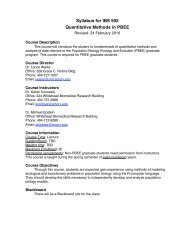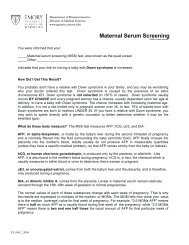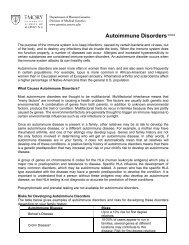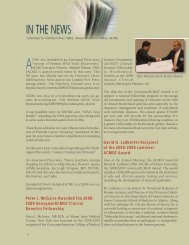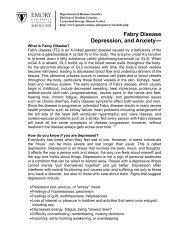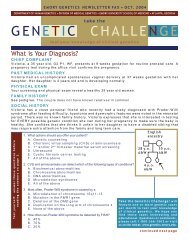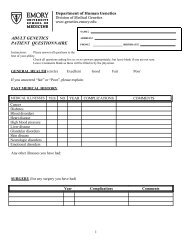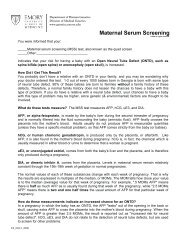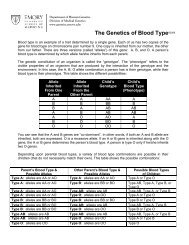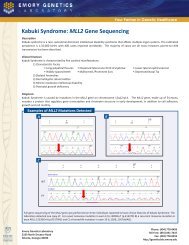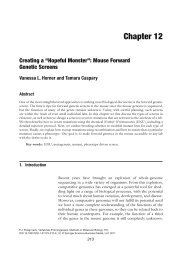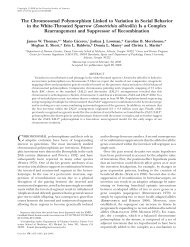Molecular Characterization of a 130-kb Terminal ... - ResearchGate
Molecular Characterization of a 130-kb Terminal ... - ResearchGate
Molecular Characterization of a 130-kb Terminal ... - ResearchGate
Create successful ePaper yourself
Turn your PDF publications into a flip-book with our unique Google optimized e-Paper software.
116<br />
which were isolated using a probe from D22S163. End<br />
fragments <strong>of</strong> these cosmids were tested by densitometric<br />
or RFLP analysis, to assess copy number in NT. Densitometric<br />
analysis showed that the proximal end <strong>of</strong> N85E7<br />
was not deleted in NT (data not shown). However, the<br />
distal end fragment <strong>of</strong> N66C4 (Xhl.2, fig. 1) showed a<br />
paternal deletion by RFLP analysis (fig. 3). The cosmid<br />
walk was therefore extended from the distal end <strong>of</strong><br />
N66C4 for three rounds <strong>of</strong> end-fragment walking. The<br />
two contigs overlap by about three cosmid lengths<br />
('100 <strong>kb</strong>) and span '150 <strong>kb</strong> between the proximal<br />
end <strong>of</strong> N85E7 and the 22q telomere. Since ARSA was<br />
not present by hybridization within the combined contig,<br />
D22S163 maps distal to ARSA. This also places<br />
ARSA at a maximum distance <strong>of</strong> 250 <strong>kb</strong> (120 <strong>kb</strong> + <strong>130</strong><br />
<strong>kb</strong>) from the 22q telomere.<br />
FISH Indicates That the NT Microdeletion Is <strong>Terminal</strong><br />
When the cosmid walk reached the N94H12/N1G3<br />
region, densitometric analysis could no longer be used<br />
to determine the copy number in NT; presumably this<br />
is because <strong>of</strong> the presence <strong>of</strong> the subtelomeric repeats<br />
shared with other chromosomes (Ning et al. 1996). As<br />
a result, FISH was used to test for deletion in NT. The<br />
most distal cosmid <strong>of</strong> the contig (P103) was labeled and<br />
hybridized to NT metaphase spreads, in combination<br />
with the chromosome 22 alpha-satellite probe to mark<br />
the centromere <strong>of</strong> both chromosome 22s. P103 hybridized<br />
to many chromosome ends, as well as 2q13, the<br />
fusion site <strong>of</strong> two ancestral chromosomes (Ijdo et al.<br />
1991). Only one chromosome 22 hybridized to P103<br />
(fig. 4). This result indicates that the entire cosmid contig<br />
is deleted in NT distal to D22S163.<br />
Localization <strong>of</strong> the Breakpoint <strong>of</strong> the NT Microdeletion<br />
Since the proximal end <strong>of</strong> N85E7 was not deleted,<br />
while the distal end <strong>of</strong> N66C4 showed a paternal dele-<br />
L0j<br />
-2.7 <strong>kb</strong><br />
-1.3 <strong>kb</strong><br />
-0.9 <strong>kb</strong><br />
Figure 3 RFLP analysis, showing that Xhl.2 is deleted in NT.<br />
The autoradiograph shows the NT family genomic DNA digested with<br />
TaqI and probed with Xhl.2. Each individual shows a constant 2.7<strong>kb</strong><br />
band. The father is homozygous for the 0.9-<strong>kb</strong> allele, and the<br />
mother has both the 1.3-<strong>kb</strong> and 0.9-<strong>kb</strong> allele. NT inherited the 1.3<strong>kb</strong><br />
allele from the mother but no allele from the father.<br />
Am. J. Hum. Genet. 60:113-120, 1997<br />
Figure 4 FISH, showing that the most distal cosmid in the contig<br />
is deleted in NT. A chromosome 22-specific alpha-satellite probe,<br />
appearing as green (FITC) centromeric signals, was used to identify<br />
the two chromosome 22 homologues. Cosmid P103, appearing as red<br />
signal (rhodamine), was observed on one homologue and deleted on<br />
the other homologue (arrows). Since cosmid P103 contains subtelomeric<br />
repetitive sequences, the red signals are also present on some<br />
telomeres <strong>of</strong> other chromosomes as well as chromosome 2q13 (arrow<br />
head).<br />
tion by RFLP analysis, these results indicated that the<br />
breakpoint <strong>of</strong> the NT microdeletion is within the N66C4<br />
and N85E7 region. An additional probe (H5.0), which<br />
is 6.5 <strong>kb</strong> proximal to D22S163 (fig. 1), showed no deletion<br />
by densitometric analysis (data not shown), further<br />
narrowing down the breakpoint. In order to look for<br />
DNA rearrangement fragments indicative <strong>of</strong> the<br />
breakpoint, genomic DNAs from a normal control and<br />
the NT family were digested with HindIII, SmaI, EcoRV,<br />
and NgoMI, electrophoresed, blotted, and hybridized to<br />
the D22S163 probe. Novel smeared bands in the 9-11<strong>kb</strong><br />
range were present in HindIII and SmaI digestions<br />
<strong>of</strong> NT DNA (fig. 5). This smear is characteristic <strong>of</strong><br />
breakpoint-junction fragments fused with telomeric sequences<br />
that are heterogeneous in length (Wilkie et al.<br />
1990). D22S163 also detected the presence <strong>of</strong> a large<br />
rearrangement band in NT with EcoRV and NgoMI<br />
digests (fig. 5). The presence <strong>of</strong> these wide rearrangement<br />
bands suggested that NT has terminal deletion and<br />
that the breakpoint is within D22S163. One discrepancy<br />
between this study and that <strong>of</strong> Flint et al. (1995) is<br />
that we detected HindIII-, SmaI-, EcoRV-, and NgoMIrearrangement<br />
fragments with the D22S163 probe,<br />
while Flint et al. (1995) detected a paternal deletion with<br />
the same probe, using Sau3AI. We hypothesized that<br />
under normal electrophoretic conditions, the smaller<br />
Sau3AI-smeared rearrangement band could be diffused




